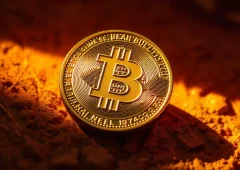Web3 Games Cool Off, but Infrastructure Is Quietly Booming
17.05.2025 20:00 1 min. read Alexander Stefanov
The hype around blockchain gaming has taken a noticeable dip, but industry insiders suggest the lull may signal something positive: maturation.
In April, daily active wallets in Web3 games dropped to 4.8 million, a 2025 low. Investment also tumbled—down 69% from the previous month to $21 million. For the first time, gaming no longer dominates the decentralized app space, now tied with DeFi at 21% user share, according to DappRadar.
But numbers alone don’t tell the whole story. According to analyst Sara Gherghelas, this is less of a crash and more of a course correction. Speculative “play-to-earn” projects are fading, while attention shifts to infrastructure, retention, and real engagement.
So far this year, two-thirds of blockchain gaming investment has gone into core infrastructure—a sign that developers are preparing for long-term scalability, not short-term hype.
While investors explore other trends like AI and real-world asset tokenization, established players haven’t abandoned the space. Ubisoft’s work with Immutable and Sega’s blockchain integrations show that traditional gaming giants are still testing the waters.
“This isn’t failure—it’s refinement,” Gherghelas said. “The noise is dying down, but the builders are still here.”
-
1
German State-Owned Development Bank Issues €100 Million Blockchain Bond
11.07.2025 7:00 2 min. read -
2
Tether Ends Support for Five Blockchains in Infrastructure Shift
12.07.2025 11:30 2 min. read -
3
Cardano and Ethereum Lead in Developer Activity as GitHub Commits Surge
14.07.2025 12:00 1 min. read -
4
BNB Chain Upgrades and Token Delistings Reshape Binance Ecosystem
16.07.2025 22:00 2 min. read -
5
Ripple Powers UAE’s First Tokenized Real Estate Project via XRPL
16.07.2025 21:00 2 min. read
U.S. Public Pension Giant Boosts Palantir and Strategy Holdings in Q2
According to a report by Barron’s, the Ohio Public Employees Retirement System (OPERS) made notable adjustments to its portfolio in Q2 2025, significantly increasing exposure to Palantir and Strategy while cutting back on Lyft.
Key Crypto Events to Watch in the Next Months
As crypto markets gain momentum heading into the second half of 2025, a series of pivotal regulatory and macroeconomic events are poised to shape sentiment, liquidity, and price action across the space.
Here is Why Stablecoins Are Booming, According to Tether CEO
In a recent interview with Bankless, Tether CEO Paolo Ardoino shed light on the growing adoption of stablecoins like USDT, linking their rise to global economic instability and shifting generational dynamics.
U.S. Dollar Comes Onchain as GENIUS Act Ushers in Digital Era
In a statement that marks a major policy shift, U.S. Treasury Secretary Scott Bessent confirmed that blockchain technologies will play a central role in the future of American payments, with the U.S. dollar officially moving “onchain.”
-
1
German State-Owned Development Bank Issues €100 Million Blockchain Bond
11.07.2025 7:00 2 min. read -
2
Tether Ends Support for Five Blockchains in Infrastructure Shift
12.07.2025 11:30 2 min. read -
3
Cardano and Ethereum Lead in Developer Activity as GitHub Commits Surge
14.07.2025 12:00 1 min. read -
4
BNB Chain Upgrades and Token Delistings Reshape Binance Ecosystem
16.07.2025 22:00 2 min. read -
5
Ripple Powers UAE’s First Tokenized Real Estate Project via XRPL
16.07.2025 21:00 2 min. read


